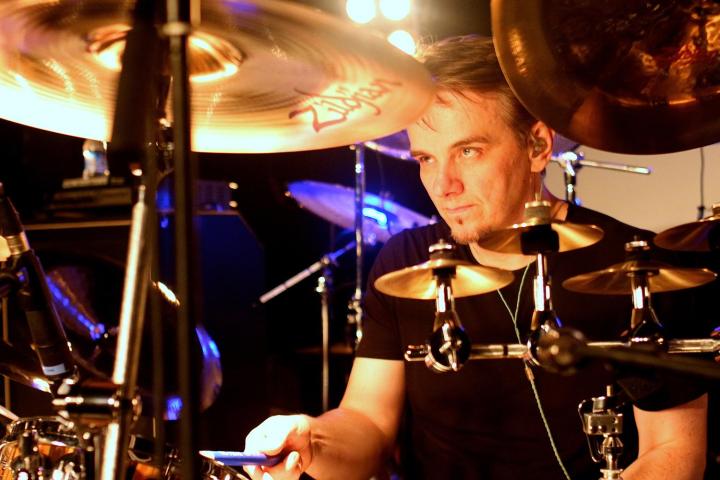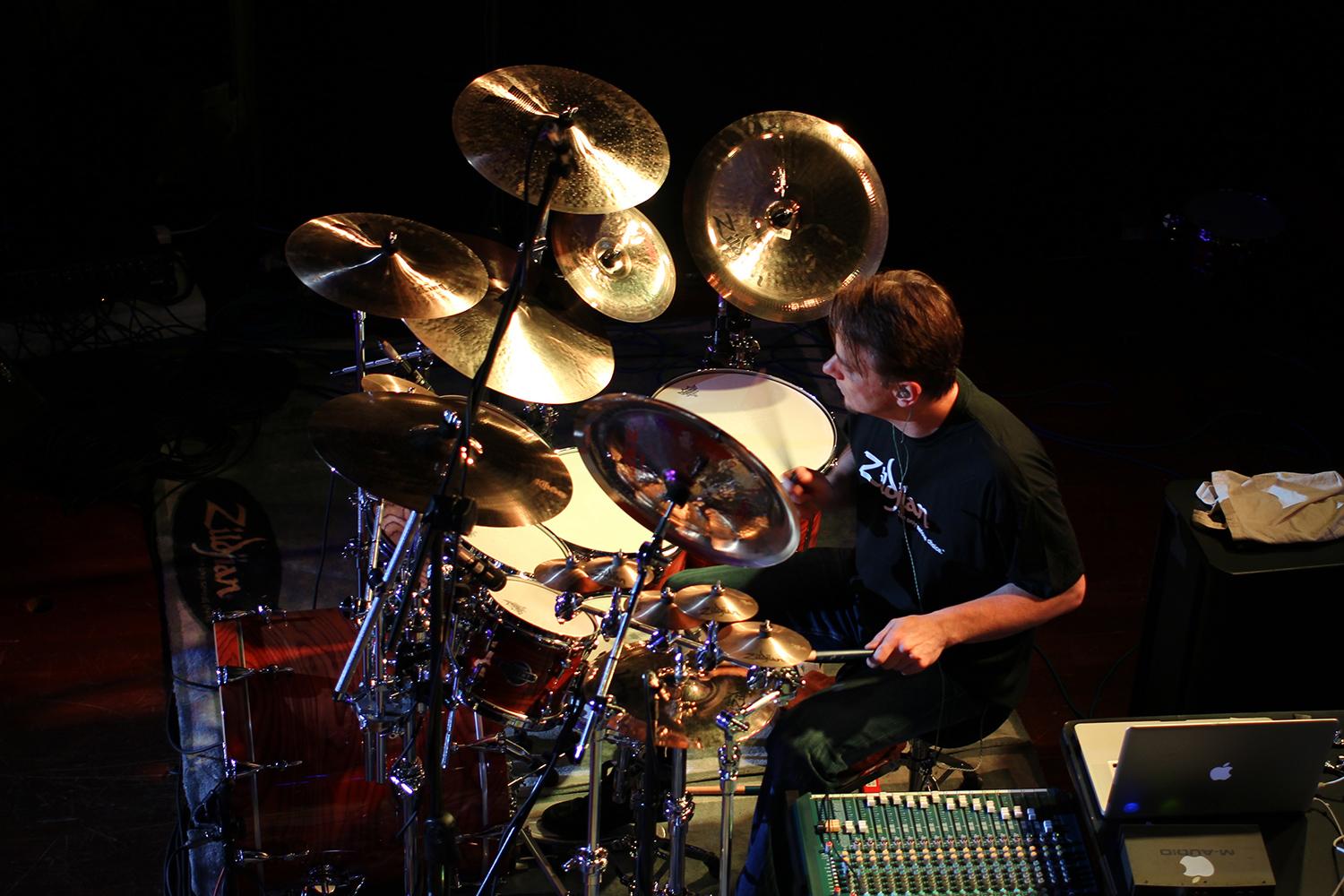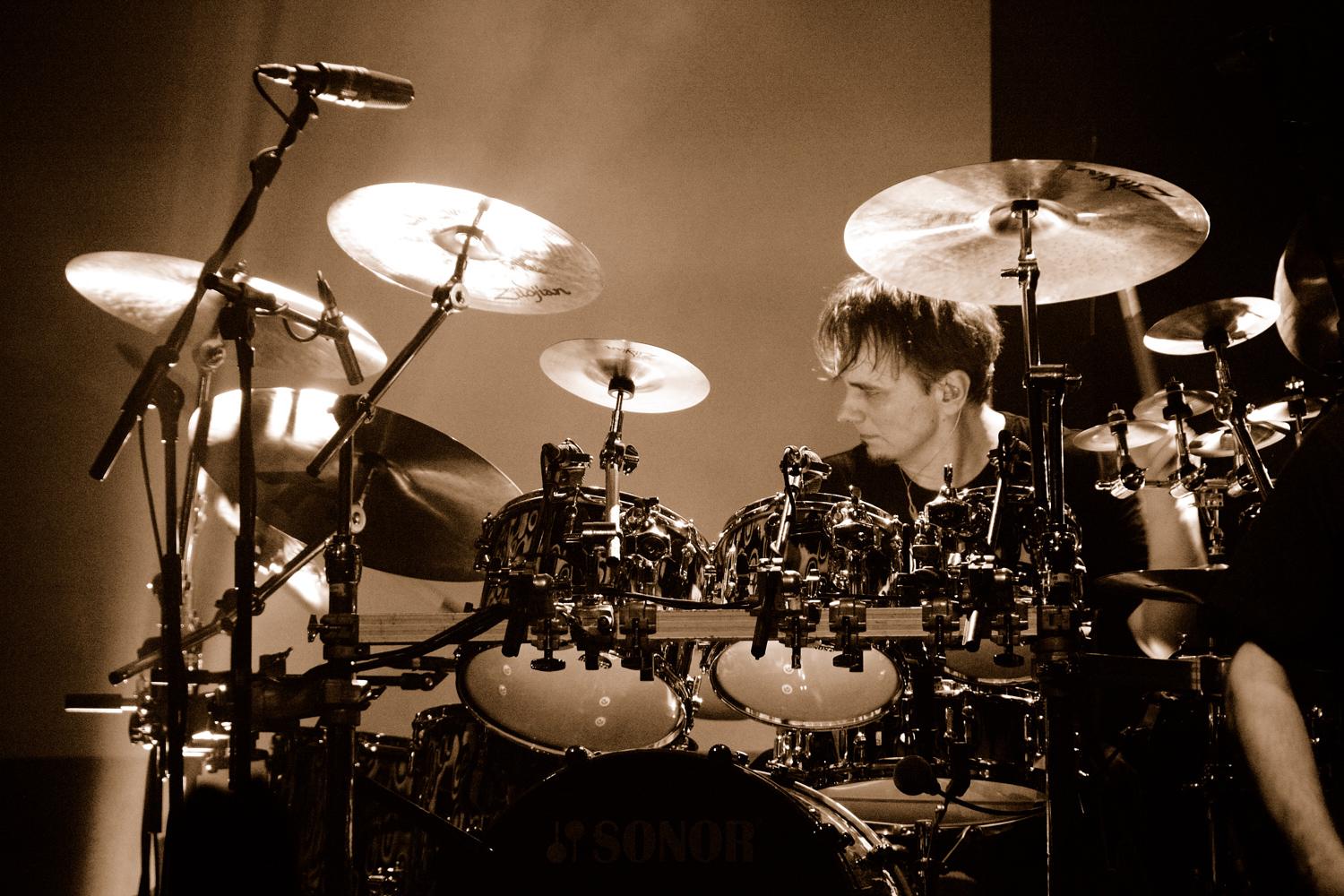
“For a project like this, surround sound gives you a lot more room to hear the details.”
When a drummer is acknowledged as occupying the same rarefied air as Rush’s Neil Peart, it says a lot about just how damn good the man really is behind the kit. But rather than bask in comparisons, Gavin Harrison, the powerhouse skinsman for the ever-adventurous (albeit on hiatus) post-progressive heroes Porcupine Tree and pioneering progressive giants King Crimson, decided to test his skills by putting his formidable chops behind a passion project five years in the making. The result, Cheating the Polygraph, was released today in various formats, including a 5.1 surround mix done by the man himself. PT fans will instantly recognize all of the songs titles, even if they don’t necessarily glean the corresponding arrangements upon first listen. (That’s OK — neither did Porcupine Tree’s singer, guitarist, and chief songwriter, Steven Wilson!)

As modern a drummer as Harrison is, his DNA is actually rooted in jazz and big band. “I suppose it’s what Americans would call a Bucket List record,” Harrison laughs. “I grew up around that kind of music because my father was a professional trumpet player. Right from my early childhood, he would have friends come around the house and jam, and it was very exciting to be around that as a child. Despite the fact that I don’t really play much jazz or play in a jazz group, the sound of brass instruments, especially in the kind of configuration as you’ll hear on this record, never left my bloodstream.”
While Harrison was prepping for the next phase of King Crimson (“The band is very much an ongoing concern; there’s no talk of it being a flash in the pan”), Digital Trends called across the pond to discuss the finer details of Polygraph and polyrhythms, recording instruments individually for 5.1 mixing, and creative arranging. It’s more than a quiet life that leaks from his head.
Digital Trends: Did you record Cheating the Polygraph at 96/24?
Gavin Harrison: It was all recorded at 96k/24-bit resolution on the highest possible quality converters and microphones. We used ribbon mikes, Royer mikes, and Neumann mikes. But I’ll be honest — I’m not one of those guys who feels he can hear the difference. You could play me a bit of music at 96k/24-bit, and then you could play me the same piece of music at the same volume at 44.1k/16-bit — I can’t hear the difference.
Not everyone hears the same way, but your Porcupine Tree compatriot Steven Wilson and I were talking about this very thing back in February. At 96/24, we both can hear subtle differences, not necessarily dramatic ones — though sometimes you do. But if you’re able to record at 96/24, there’s nothing to lose, and everything to gain.
Right. The only down-conversion happens right at the very end, after the mastering. I do have all the files at the same quality as they were recorded at.
You mixed Polygraph in 5.1, something you also had done for your two collaborations with 05Ric [2009’s Circles and 2012’s The Man Who Sold Himself]. And, of course, Steven did more than his share of surround mixes for Porcupine Tree. What do you like about surround sound?
For a project like this, it gives you a lot more room to hear the details. It really does come alive in surround sound, because sometimes there are 18 instruments playing at the same time, and since everyone’s playing a different note or a different rhythm, it’s nice to be able to hear that. In surround, you’ve got more room to move them around the room and have things exactly as you want.
Part of this is due to the way we recorded it. Some people have asked me, “What studio did you record all of the brass players in?” The truth is, every single instrument was recorded one at a time. If I wanted to, I could have booked a studio and had 14 brass players turn up to do it. But this stuff is really, really hard to play. You could imagine — if one person makes a mistake at any point, you’re going to hear that mistake on all the other microphones. You have to get rid of it, so you’re going to have to do it again, or you’re going to have to drop in. That, times 14, is a very tall order.
“But I’ll be honest — I’m not one of those guys who feels he can hear the difference.”
There are a couple of advantages to doing parts one at a time. You can have the same trumpet player play all four trumpet parts. You can have the same sax player play all five sax parts. It’s unbelievably tight, because it’s the same person with the same sense of rhythm, the same sense of tuning, and the same sense of intonation. What that gives you is the chance of capturing the most accurate performance of the arrangement.
Secondly, it means that when you come to do the surround mix, you can place an instrument in any position in the field. If I’d recorded all five saxophonists all sitting together in a room, you would hear each sax on all the other mikes as well. What it means is that, in the surround mix, I could place one trombone in each speaker, completely discretely, with no crosstalk. You couldn’t do that if you recorded four trombone players sitting next to each other.
I know it’s not the “traditional” way to record big band, and probably purists wouldn’t like it at all once they knew that fact. But of the people I’ve asked, without them knowing that fact, they all believe we played it together in one room.
I have to admit — it does sound like everyone played together. Is there one particular Polygraph song that encapsulates your surround philosophy?
The first song we actually wrote with that in mind, What Happens Now? [originally from Porcupine Tree’s 2007 mini album, Nil Recurring]. This arrangement starts with all the brass instruments coming in one at a time, and they all play a different rhythm — six or seven different polyrhythms, all playing against each other. And when I place the instruments in separate speakers, as they come in, you really get a big trip when you’re sitting in the middle. You’ll hear those rhythms coming at you from different angles. In surround, it will really blow your mind. Every time a new instrument came in, I made sure it was the furthest away from the previous instrument. So the polyrhythms the brass are playing in the first minute really stand out.

And there were certain moments throughout the whole project where I’d think of the surround possibilities — like when I was recording my marimba and when I was overdubbing two or three marimbas at the same time. I knew how I would place them in the surround mix as well as in the stereo mix.
There are some fun effects too. I recorded myself playing a 12-inch gong, and when you hear it in the surround mix, it actually spins all the way around your head. Little things like that.
I love that stuff. I don’t think I could ever listen to music like this on MP3, that’s for sure. I’d literally be cheating myself.
I don’t tend to go the MP3 route either. What I actually listen to is the music, the arrangement, and the performance. I’d rather hear a shit cassette of great music than a 192k/24-bit Blu-ray disc of something I don’t like, you know what I mean? But once in a blue moon, you do get some of the music that you like in the highest fidelity. Like Steve’s surround mix of [Porcupine Tree’s 2007 album] Fear of a Blank Planet — that one turned out pretty good.
In a lot of ways, Polygraph feels like a film score.
Oh, completely, yeah. Laurence Cottle wrote the charts out, and he did the arrangements. We sat down and talked for a long time about the concept of doing this record, how we could do it, and what instrumentation we could use, because we extend the traditional with clarinets, bass clarinets, harmonium, tuba, and all kinds of other instruments that are more akin to a cinematic orchestra rather than traditional big band, which just focuses on trumpets, saxes, and trombones.
“The truth is, every single instrument was recorded one at a time.”
Laurence and I talked a lot about “the big idea.” If you have a good “big idea,” the rest is just details. If you start with the details, all you can hope for is that if all the big ideas pile on top of each other into an interesting mountain. (laughs) It’s a very dangerous way to set off, with this being such an elaborate project and such an expensive project. That’s why I chose the idea of doing all Porcupine Tree songs. If we had just set off writing original big-band material, I doubt we’d be having this phone call right now. (laughs) And I think people would be a lot less curious to hear it. It would be equally as good, but without that angle of it being Porcupine Tree songs. I didn’t really want to write eight original pieces. That wasn’t really what I was trying to do.
How did the project get underway?
The first one we did for it, Futile [originally the title track to a 2003 PT EP], happened kind of by accident. I was invited to play at a Buddy Rich Memorial Concert by his daughter Cathy. She said, “Look, you’re welcome to play any of Buddy Rich’s charts, but why don’t you do a chart of one of your band’s songs?” I said, “Wow, Porcupine Tree is nothing like this.” But I got off the phone and I thought, “Well, I know a great arranger in Laurence Cottle, so why couldn’t we do this?” So we came up with the arrangement of Futile, and it worked great.
Everything worked the way I hoped it would work. It was never, at any point, meant to be “jokey” or have a sort of comedic element to it. It would be very easy to do an album of Porcupine Tree songs played on trombone; it would just be funny. But that was not what I was trying to do.
Toward the end of Futile, you have a quick solo burst, maybe 5-10 seconds long — could we call that your Buddy Rich moment?
No, there’s a moment in the Anesthetize segment called The Pills I’m Taking [originally from 2007’s Fear of a Blank Planet], where I give a nod to Buddy Rich, if you know his material very well. There’s a short break that’s really a copy of Buddy Rich’s snare-drum break during “Love for Sale” [from 1967’s Big Swing Face]. Every drummer who knows Buddy Rich knows this break, and I copied that.
At the beginning of Futile, I actually give a reference to Gene Krupa, who was really the pioneer who brought drums to the forefront of music. For Gene Krupa and a lot of those early guys, the drums were literally a dull thud in the background of a band ticking along. It was never a featured instrument. When Gene Krupa did his version of Sing, Sing, Sing (With a Swing) with Benny Goodman [in 1937] and he played that rhythm on the floor toms, he started a revolution that led to the modern drum set and the concept of modern drumming. I thought it would be nice to start that particular arrangement with a little quote of Gene Krupa.
I didn’t choose to do the record with a classic, typical jazz drum sound. I didn’t choose to go with a Buddy Rich drum sound. I don’t want to do an impersonation of Buddy Rich, and I’m sure he wouldn’t have wanted me to do it either. (laughs) That’s not my voice. My voice is the modern drum set that I play. I’ve had a much similar sound for the past 25 years that I’ve settled on and think of as “my voice.” I wanted to use my voice. A really classic jazz sound wouldn’t have worked on all of the songs. It certainly wouldn’t have worked on a song like Hatesong/Halo.
While the record actually did take five years to complete, I recorded all of the drums close to the end of the project in the space of about a week, because I wanted the same drum sound on every track.
How did you decide to thread certain songs together like you did with Hatesong/Halo? Those two songs come from different worlds.
We tried speeding up Hatesong to match the tempo of Halo, and we tried slowing Halo to match Hatesong, and neither of them worked like that. They’re two completely different pieces separated by a few years. [Hatesong is from 2000’s Lightbulb Sun; Halo is from 2005’s Deadwing.]
With some clever modern arranging methods, such as metric modulation, you can find very smooth ways to go from one tempo to another so you can’t see the join. And vice-versa. When we come out of Halo, we’re using the triplet subdivision that becomes the 16ths of Hatesong, and when we go back to Hatesong, it’s two-thirds the tempo of Halo. We also use some metric modulation in Heartattack in a Layby.
I also hear a lot of Frank Zappa within these grooves.
Obviously, there are bits of Frank Zappa in there, and there are bits of Bob Brookmeyer, moments of Don Ellis, Lalo Schifrin, Patrick Williams, Prokofiev, and some moments of Gil Evans. Laurence was influenced by a 20th century French composer, Olivier Messiaen, and that’s really modern contemporary orchestral stuff — nothing like jazz or big band, but we liked a lot of that kind of harmony.
“The sound that you make on your own instrument is absolutely vital to you. It’s your voice.”
Hatesong uses this repetitive tone row, which is very similar to something Steve Reich would do — a series of pitches that play through a sequence before repeating. There are also little bits of Stravinsky in there. There’s even a tiny Tower of Power riff in the middle of Halo. You’d be pretty lucky to spot it. There are hidden gems in there, if you want to find them.
You don’t have to like Porcupine Tree or even know the Porcupine Tree songs to enjoy this record. I wanted it to be enjoyable even if you’d never heard of Porcupine Tree. It’s not necessary that you know the original. It’s fun if you do the original, but you really don’t have to know the original songs to enjoy it.
In a lot of cases, you don’t even give that many cues or callbacks to the original songs. Maybe the bassline in Hatesong/Halo and The Pills I’m Taking will remind you of those melody lines, but for the most part, these often sound like original pieces to me.
The way I think of it is like this: You’ve given a photograph of something to Picasso and you’ve said to him, “Make a painting that represents the way you feel about this photograph.” (laughs) That’s how these arrangements are. They’re not note-for-note covers, as I’ve said earlier. You won’t be whistling or singing along. You might recognize the odd riff here and there, and you might recognize in The Sound of Muzak where there’s a section where the brass actually play very closely to Steve Wilson’s original guitar solo. But you have to know the original guitar solo, or at least compare it, to work out how we did it.
I’ve spoken to Steven recently about his solo album Hand. Cannot. Erase., and he said when you had played some of this material for him, he didn’t even recognize some of those songs!
(chuckles) I started this project such a long time ago that there would be times where Steve, Richard [Barbieri, keyboardist], or Colin [Edwin, bassist] would be ’round my house where we’d be having a band meeting or be meeting about something else, and I’d say, “Hey, check this out!” I’d play it without telling them what it was. Whatever song I’d most recently been working on, I’d play them that arrangement, and sometimes it took a couple of minutes before one of them said, “Hang on, that sounds a bit like…” — and then they’d name the song.
It’s interesting to me how people listen to music. They only recognize it when they hear the original instrumentation. Maybe they’re listening more to the sound than the notes and the melody. All is good, you know. If you hear music from a “sound” perspective, that’s fine as well. If you don’t recognize some of these songs because Steve’s not singing them and you can’t hear his distorted guitar, Richard’s keyboards, Colin’s bass, or even the original drum rhythm that I wrote, that’s fine. Maybe you listen to music in a different way than some other people.
What I have a problem with is separating the sound from the music. When I’m mixing, I’m listening more to the music than the sound. I don’t spend three hours EQ’ing a bass drum. I’m listening to what the bass drum is playing more than the sound of the bass drum.
For you, performance comes first.
Of course, of course. I’m listening to the music more than the sound. Divorcing one from the other is a hard thing to do when you’re a musician. If you’re a sound engineer, you can divorce the sound of the instrument away from the music that it’s making. Of course, sound is important, but the sound that you make on your own instrument is absolutely vital to you. It’s your voice.





